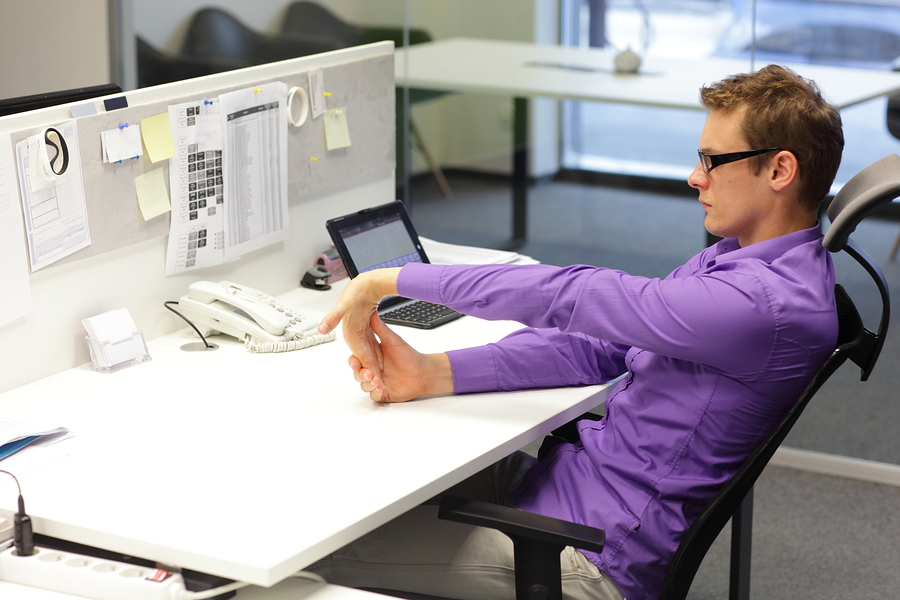- Make It Yourself Lavender Heart-Shaped Bath Bombs!
- 20 Things You Never Knew About “Down There”
- 12 Best Foods For Those Suffering From Arthritis Pain
- 12 Personal Hygiene Mistakes Almost Everyone Makes (Mom Never Told You About #4!)
- 15 Medicinal Plants And Herbs From The Cherokee People
- 12 Mind-Blowing Benefits Of Drinking Coconut Water During Pregnancy
- 12 Outstanding Winter Foods That Won’t Fatten You Up Like A Christmas Turkey
The Top Health Risks Every Office Employee Should Know About!

Photo credit: bigstock.com
For countless millions of people in the modern world, going to work means sitting in an office and typing away. Even people who work in very different industries can end up doing many of the same physical tasks: hunching over a keyboard to type, sitting through meetings, sitting while making a phone call, and sitting, sitting, and sitting some more.
Regardless of what the mind is focused on, the physical effects on the body are the same. While most people wouldn’t think working in an office is a very dangerous job, the truth is a little more troubling. Remaining sedentary for prolonged periods of time can have seriously harmful effects on the body.
If you’re reading this from a cubicle right now, don’t fret. In this article, we’ll discuss the top health risks facing office employees and share some practical steps you can take to reduce your risk of health problems associated with this lifestyle.
Sedentary Lifestyle
The most obvious health risk that might come to mind here is just a sheer lack of exercise. If you’re sitting still, it means you’re not moving around, and if you’re not moving around, you’re not getting any cardiovascular or muscular use out of your body. This sedentary lifestyle is all too common among office workers, and is frequently exacerbated at home by sitting in front of the TV or computer.
Health risks associated with an excessively sedentary way of life are unwanted weight gain and obesity, an increased risk of high blood pressure, and type 2 diabetes. It can also lead to a higher risk of depression and anxiety. According to Johns Hopkins Medicine, too much sitting can even increase the risk of developing certain forms of cancer.
Continue to Page 2

Photo credit: bigstock.com
Back and Neck Issues
Sitting down all day tends to cause office workers to hunch over their desks, putting pressure on the neck and certain parts of the spine, which frequently leads to back pain. This is one of the most common reasons for missing work, costing individuals, companies, and governments millions of dollars per year in medical bills and lost wages.
The angle at which your computer monitor is tilted can also affect your neck. If you’re tilting your head to see your screen more clearly, this will cause neck pain quite quickly. Neck pain can also be caused by the practice of cradling a phone between your head and shoulder.
Eye Problems
Finally, an office lifestyle can affect you in a way that’s subtler, but still quite serious. Office workers usually stare at a computer screen all day. Numerous studies have now shown that spending too much time looking at a surface close to the eyes like a computer screen, tablet or smartphone can significantly increase the likelihood of developing near-sightedness.
Additionally, the light emitted by the screen can affect the brain. If you’re working late, the blue light emitted by the screen can negatively influence the circadian rhythm in your brain. Your brain misinterprets the blue light as daylight, throwing off your circadian rhythm and making it more difficult for you to fall asleep at night. Sleep deprivation can lead to a whole other set of negative health consequences. Isn’t it amazing how all these side effects of working in an office can lead to a downward spiral of health problems? What can be done about this?
Solutions
The first order of business is to start moving more! Try not to sit more than an hour at a time. Get up, walk around and stretch, even if it’s just a for a few minutes.
READ ALSO: Dangerous Toxins Lurking In Your Office And Ways To Avoid Them Infographic
You should also be exercising regularly. That doesn’t necessarily mean running 5ks or killing yourself on the squat rack, but you should be getting some form of regular exercise. Cardiovascular exercise is the most important. Going for a short walk every day will go far in reducing your risk of most of the health problems mentioned above. You can also try sitting in an ergonomic chair and taking steps to improve your posture. Changing the position you remain in for a long part of the day will greatly reduce your risk of back and neck pain.
References:
































